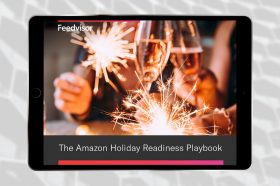Resources - Blog
Amazon Holiday Prep Series: Using Technology to Optimize Key Business Areas

Stay on top of the latest e-commerce and marketplace trends.
The Amazon holiday prep series will run throughout Q4, as well as the weeks leading up to and following the peak selling season. It will focus on relevant e-commerce holiday news, as well as actionable strategies you can implement to achieve your sales goals and carry momentum into the new year.
With the busiest selling season of the year rapidly approaching — and digital channels on pace to beat out in-store holiday shopping — the time is now to ensure your supply chain is in shape to withstand the increase in demand, optimize your product detail pages to drive engagement, and leverage data to help you make decisions about your Q4 sales forecasts.
A firm understanding of your timeline — such as sending inventory to FBA by Amazon’s to-be-announced deadline — and budget will be immensely helpful so you can anticipate what you can spend on advertising and promotions for key shopping days such as Black Friday and Cyber Monday or determining how much to allocate toward existing items in your catalog versus new or holiday-specific products.
In this article, we will discuss three critical applications that illustrate the importance of managing your catalog with AI-driven technology year-round, but particularly during periods of high search traffic and sales volume such as Q4.
1. Price Optimization
According to Feedvisor data, 33% of Amazon sellers are utilizing repricing technology on Amazon and the overwhelming majority (90%) find it to be helpful in some capacity. Moreover, 94% of those sellers find their account health score to be above average compared to their competitors.
Having a healthy account in the eyes of Amazon during the weeks leading up to the holiday season is pivotal — perfecting your FBA strategy and sourcing popular items will be for naught if your selling privileges are revoked. Now is the time to audit your account to ensure total compliance with Amazon’s Terms of Service, make headway on any intellectual property complaints, and make sure your product detail pages are accurate.
Technology can help automate a lot of these tasks, but, most importantly, it can also price your products with machine-learning algorithms that continuously assess market dynamics and changes in the competitive environment.
The myriad of data points from your business’s operation, the market, and your competitive arena are considered and analyzed. They are examined holistically and used to make stronger predictions and demand forecasts for the future. Harnessing an AI-driven platform for price optimization can help you grow sales and scale profitably, particularly during the peak holiday season.
2. Inventory Planning and Returns Management
Having an in-depth understanding of your Amazon business’s inventory position is of utmost importance from October through December, as slow-moving or non-selling items can easily compromise your profits. With Amazon FBA, storage costs can add up substantially if the inventory is stagnant for too long.
The company may also deny certain items that do not hit specific demand thresholds, as its fulfillment centers are inundated with an influx of Q4-specific inventory and looks to only stock products that are guaranteed to move.
In order to avoid facing IPI storage access limits and inventory storage overage fees, you need a 360-degree view of what items to restock, the appropriate times to do so to avoid stocking out — which can hurt your performance metrics — when to discontinue an item or dispose of stale inventory, and when you are noncompetitive on an item.
By leveraging a technology platform that allows you to receive both comprehensive and granular snapshots of your business, you can easily extract the insights you need at a given time and transform the information into action to fuel business growth.
Additionally, given that more than one million returns were processed by UPS on Jan. 3, 2019, you need to take an active approach to returns management before it is too late. In order to maximize the growth opportunities this holiday season, you need to know which variables of your business impact your profitability and to what extent. These can include elements such as storage and fulfillment fees, shipping costs, cost of goods sold (COGS), operating costs, advertising spend, costs associated with processing returns, and more.
With nearly $25 million worth of items returned on Amazon every year, be sure to track the reason for each return in order to effectively understand the root cause of each one and simultaneously drive down your return rate. You can use tools to set alerts for different reasons or create reports to see the volume of your returns. Feedvisor’s returns dashboard allows you to slice-and-dice your returns data by volume, value, SKU, vendor, and brand to show how returns impact your profitability and overall operation.
3. Scouting for New Products
Analyzing your catalog’s SKU-by-SKU performance is an ongoing process, as you regularly revisit which products you should keep selling and which ones you should discontinue. Like inventory planning, assortment planning requires data and forecasting.
You need to monitor trends and changes in demand to understand each product’s competitiveness. Although you can analyze the past performance of products and their categories, accurate forecasting requires a sophisticated algorithmic model and the support of AI-based technology.
It must assess the relationships between products, influences of events such as holidays and seasons, and the impact of competition and pricing. Although your scouting for new products to sell during the holiday period should be complete, scouting is a project you can always work on during lull periods or times when sales are softer, such as certain days in Q1. By leveraging scouting software, you can receive real-time information on a product before you officially add it to your mix.
The technology can provide data such as estimated sales and profits figures, list and Buy Box price, and daily demand to allow for precise sourcing decisions throughout the year. By using technology to help power your assortment planning, you are mitigating the risk associated with adding new products to your catalog and help you find the niche opportunities that will ultimately make a difference to your bottom line.
Final Thoughts
The sheer volume of anticipated sales makes Q4 an exciting block of time for sellers and brands on Amazon — estimates show that U.S. retail spending is slated to pass $1 trillion in November and December for the first time in history.
With that growth on pace to extend to both mobile and e-commerce, finding the right mix of ad campaigns and promotional opportunities, leveraging bespoke ways to separate your brand apart such as with social media promo codes or a unique social campaign, and ensuring a sound inventory position will be pivotal during the weeks leading up to the busiest shopping days of the year.
Learn what Feedvisor can do for your business.
When you partner with Feedvisor, you automatically receive access to our true, AI-driven technology and hands-on team of e-commerce experts. Contact one of our team members today to learn more about our end-to-end solution for brands and large sellers on Amazon, Walmart, and e-marketplaces.



